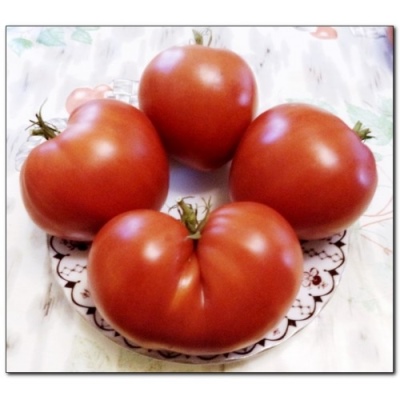
- Authors: Russia
- Category: grade
- Growth type: indeterminate
- Appointment: universal
- Ripening period: mid-season
- Ripening time, days: 105-110
- Growing conditions: for greenhouses
- Bush size: tall
- Bush height, cm: 150-180
- Bush characteristic: powerful
Tomato variety Kangaroo heart belongs to a universal group. It allows you to get a full-fledged large harvest. It can be grown both in the open field and in greenhouses and hotbeds.
Description of the variety
This variety has an indeterminate growth pattern. She is tall. The height of a healthy adult bush reaches an average of 150-180 centimeters. The bushes are quite powerful, the leaf blades are of the usual type.
The main qualities of the fruit
Ripe tomatoes are dark red in color. All of them are large enough. The mass of one vegetable is approximately 300-500 grams.
The shape of ripe healthy fruits is heart-shaped. The pulp of mature vegetables is juicy, fleshy and dense. The skin is also very firm.
Taste characteristics
Tomatoes of this variety have a harmonious taste with a pleasant sour aftertaste.
Ripening and fruiting
Tomatoes Kangaroo Heart are mid-season. Ripening dates come in 105-110 days after planting seeds in the ground. The fruiting type of this variety is long-lasting.
Yield
The kangaroo heart is a high-yielding species. It will be possible to collect up to 4 kilograms of vegetables from one adult bush.
The timing of planting seedlings and planting in the ground
Sowing seedlings should be carried out about 60-65 days before planting in open ground. Planting in open soil is performed most often in early May.

Growing tomato seedlings is an extremely important process, because it largely depends on whether the gardener can harvest at all. All aspects must be taken into account, from seedbed preparation to planting in the ground.
Landing scheme
When planting such tomatoes, a free space of 70-75 centimeters should be left between individual seedlings. They also make a distance between rows with bushes of 80-100 centimeters.

Growing and caring
First, you need to grow strong and healthy seedlings. To do this, you need to prepare a mixture of sand, humus and garden soil. And all this is mixed in the same proportions.
You will also need to prepare the required number of containers for seeds, sometimes a common container is used. The previously prepared earth mass is poured into it. The seeds are neatly laid out on its surface and slightly deepened.
Immediately before sowing, it is recommended to treat the seeds with disinfecting compounds. In the process of seedling growth, it will be necessary to regularly remove all processes that are lagging behind in development.
Also, plants will need watering and top dressing. At the initial stage, it is better to use liquid substances as fertilizers; they can be purchased in specialized stores.
To prevent the vegetation from stretching, you can use fluorescent lamps. When the plant stems reach a length of 5-7 centimeters, they can begin to be planted in open ground, observing the distance between the bushes and rows.
Seedlings in containers will first need to be watered with warm water, and the ground should be treated with a solution of potassium permanganate. The vegetation is carefully laid in the previously dug planting holes, their root system is sprinkled with earth.
All this should be thoroughly watered immediately. A week after planting, the seedlings should be fed with organic fertilizers. In this case, you can use an infusion with bird droppings or mullein.
In the future, you need to use dry mineral fertilizers. An excellent option would be complex formulations that contain all the basic necessary elements.
Sometimes superphosphate is used (20 grams of substance per 1 square meter of territory). Ammonium nitrate and potassium salts are also often used.
Preventive spraying is also recommended. This can be done using ready-made compounds purchased in the store. Often, homemade infusions with herbs, wood ash, and crushed eggshells are used for this procedure. Such treatments will prevent infection of the crop with various infections, and will also help scare off harmful insects.
Further, in the process of growth and development of the crop, regular watering should be carried out as the topsoil dries out. The land between the bushes and between individual rows needs to be loosened. Moreover, it is worth carrying out such a procedure every 10-12 days.
This variety also requires a garter. Most often it is done with stakes or a tightly stretched rope. The garter is performed so that adult bushes do not break under the weight of their own large fruits.
The formation of the bush also plays an important role. It is necessary to timely carry out pinching, pinching the upper part of the stems.




A plant needs different micronutrients at each stage of growth. All fertilizers can be divided into two groups: mineral and organic. Folk remedies are often used: iodine, yeast, bird droppings, eggshells.
It is important to observe the rate and period of feeding. This also applies to folk remedies and organic fertilizers.



























































































